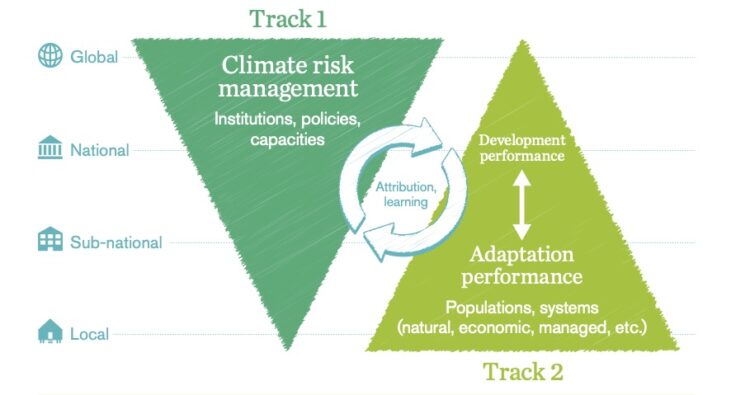Adaptation is an open-ended process that requires continous learning and iterative management. When we invest in adaptation actions, we need to monitor their effects and evaluate whether they are effective (e.g. are they making society more resilient and helping to reduce climate change losses and damages?). This helps us decide whether we should continue with existing strategies, or whether new approaches are needed. Monitoring and evaluation (M&E) and monitoring, evaluation and learning (MEL) are therefore key to designing and implementing successful adaptation responses.
A number of factors make adaptation M&E especially difficult, including the timescales over which climate change will occur, the lack of any universal adaptation metrics, and the need to account for changing climatic ‘baselines.’ For example, if losses and damages are increasing in the face of intensifying climate hazards despite adaptation actions, have these actions been ineffective, or have they prevented losses and damages from being even higher? Organisations tasked with supporting adaptation have struggled with these issues from the outset, and continue to do so.
For over a decade, Garama has been developing frameworks and approaches to support adaptation monitoring, evaluation and learning. In particular, we have focused on how to move from the measurement of outputs (e.g. expenditure, number of people supported or policies updated), to the assessment of adaptation effectiveness, typically measured in terms of outcomes and impacts, to use the language of MEL. We have undertaken pioneering work in this area, developing novel frameworks for linking adaptation with economic and social development, and relating the measurement of resilience at the outcome level to development results measured at the impact level.
Notable Garama contributions to adaptation MEL include (in reverse chronological order):
- Contributing to IISD’s 2024 Toolkit for Monitoring, Evaluation, and Learning for National Adaptation Plan Processes.
- Co-authoring IIED’s 2022 guidance on Integrating climate risks into sustainable development evaluation.
- Contributing to the publication Lessons from measuring resilience from the BRACC programme, based on an evaluation of the UK funded Building Resilience and Adaptation to Climate Change (BRACC) programme in Malawi, with NIRAS and Kulima (2022).
- Our identification of lessons around adaptation and resilience results from the UK funded StARCK+ programme, implemented by DAI, and our input to the subsequent StARCK+ final evaluation (2017).
- Leading on the methodological development of the Tracking Adaptation and Measuring Development (TAMD) framework with IIED from 2012 to 2015. TAMD relates institutional climate risk management to resilience and development results through a framework that can be used to develop systems and indicators for for diverse adaptation MEL contexts. TAMD has been piloted in numerous countries, including Cambodia, Ethiopia, Kenya, Mozambique, Nepal, Pakistan and Uganda. The TAMD framework is represented in the graphic at the top of this page. More information on TAMD, including numerous publications including this step-by-step guidance and other guidance for the application of the TAMD Framework at the national and local levels, can be found here.
- The development of initial methodological guidance for various key performance indicators (KPIs) to track performance of the UK’s International Climate Finance, including an early methodology for KPI4 to measure the number of people with improved resilience as a result of ICF support.
